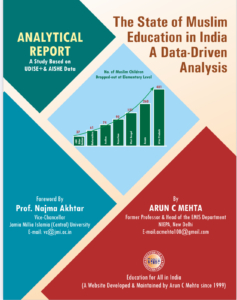Role of Educational Indicators in Decentralized Planning
Role of Educational Indicators in Decentralized Planning: Bridging Gaps in India’s School Education System
Historical Background
Educational indicators are critical tools for evidence-based planning, monitoring, and evaluation in India’s school education system, particularly under Samagra Shiksha, which was launched in 2018 to unify education from pre-primary to Class 12. Indicators such as Gross Enrolment Ratio (GER), Dropout Rates, Pupil-Teacher Ratio (PTR), and Gender Parity Index (GPI) provide quantifiable insights into access, participation, retention, quality, equity, infrastructure, teachers, and efficiency. Aligned with the National Education Policy (NEP) 2020’s goal of achieving 100% GER by 2030, these indicators enable planners to identify disparities – by gender, social category (e.g., SC/ST), or geography (district/block) – and design targeted interventions to ensure inclusive, equitable education.
The extensive analysis of indicators is vital for effective planning. For instance, a low GER in a rural block may indicate the need for new schools or transport facilities, while a high Dropout Rate could necessitate vocational programs or counselling. Disaggregated data, such as gender-specific GER or block-level transition rates, reveals local challenges, like safety barriers for girls, prompting infrastructure upgrades like separate toilets. Indicators also facilitate trend analysis, benchmarking against tools like the Performance Grading Index (PGI) or National Achievement Survey (NAS), and optimize resource allocation through Samagra Shiksha’s Project Approval Board (PAB) reviews. Without rigorous analysis, planning risks being reactive, perpetuating inefficiencies and inequities.
Despite a growing number of officers proficient in analysing indicators for Annual Work Plan and Budget (AWP&B) under Samagra Shiksha, many at state, district, block, and cluster levels lack a basic understanding of concepts like distinguishing GER from Net Enrolment Ratio (NER) or using GPI for equity planning. This gap, rooted in limited training and a historical centralized planning legacy, results in AWP&B that fail to address local realities, such as learning gaps or dropout spikes. Officers often treat indicators as reporting tools rather than strategic assets, undermining decentralized planning.
The Manual on Educational Indicators for School Education under Samagra Shiksha was developed to address this. From UNESCO guidelines, Aggarwal and Thakur’s Concepts and Terms in Educational Planning and Administration (2003), and UDISE+ analyses, it provides clear definitions, computation methods, examples, interpretations, and planning implications. The manual empowers officers to craft data-driven AWP&B by emphasizing gender-specific and disaggregated analysis, aligning with NEP 2020’s vision of universal, quality education.
A Historical Perspective on Decentralized Planning in India: The Evolution and Role of Indicators
India’s shift from centralized to decentralized educational planning has been transformative, with programs like the District Primary Education Programme (DPEP), Bihar Education Project (BEP), Lok Jumbish, and Sarva Shiksha Abhiyan (SSA) leveraging indicators for localized strategies.
Pre-1990s: Centralized Planning and Data Scarcity
Before the 1990s, educational planning was centralized under the Planning Commission’s Five-Year Plans, relying on national or state-level data from All India School Educational Surveys (AIES). With 8-10 year gaps (e.g., 3rd AISES 1973, 4th AISES 1978-79, 8th AISES being the last survey 2008-09), sub-state data (district/block) were unavailable, and indicators like literacy rates lacked disaggregation. This top-down approach ignored regional disparities, leading to uneven school distribution and persistent inequities. The 73rd and 74th Constitutional Amendments (1992) empowered Panchayati Raj Institutions (PRIs), paving the way for decentralization.
DPEP and the Rise of Indicators (1994 Onwards)
Launched in 1994 with World Bank support, DPEP shifted planning to the district level, covering 42 districts initially and expanding to 272 by 2000 across 18 states. Focusing on primary education (Classes 1-5) in low female literacy areas, DPEP used household surveys and school mapping to compute district-level indicators like GER, NER, Dropout Rates, and GPI. These guided interventions include alternative schooling and girls’ education incentives in educationally backward blocks (EBBs). The National Institute of Educational Planning and Administration (NIEPA) introduced the District Information System for Education (DISE), providing annual school-level data, reducing time lags to one year, and enabling disaggregated analysis. By 2000, DPEP increased primary GER from 82% to 95% in covered districts, demonstrating the impact on targeted planning.
Parallel Initiatives: BEP, Lok Jumbish, and Localized Planning
The Bihar Education Project (BEP, 1991), supported by UNICEF and SIDA, targeted universal primary education in Bihar’s underserved districts. Using indicators like the Age-Specific Enrolment Ratio (ASER) and repetition rates from micro-surveys, BEP planned non-formal education centres through Village Education Committees (VECs), addressing dropout rates exceeding 50% in some areas with initiatives like Mahila Samakhya. Lok Jumbish (1992, Rajasthan), with SIDA support, used community-driven planning in 75 blocks, leveraging Social Parity Index (SPI) and infrastructure metrics to deploy para-teachers (Shiksha Karmi). Village-level data raised GER from 60% to 85% by 1998. Other programs, like the Andhra Pradesh Primary Education Project (APPEP, 1985-1996) and Uttar Pradesh Basic Education Project (UPBEP, 1993), used cohort analysis for survival rates, reinforcing indicator-driven decentralization.
SSA and Institutionalized Indicator Use (2001 Onwards)
Sarva Shiksha Abhiyan (SSA, 2001) scaled decentralization to elementary education (Classes 1-8) nationwide, mandating district and sub-district AWP&B with VEC and School Management Committee (SMC) involvement. UDISE, evolving from DISE, provided annual data on over 200 variables, enabling computation of PTR, transition rates, and fund utilization at block/cluster levels. Time lags dropped to 2-3 years, and state-specific targets (e.g., Dropout Rates below 5%) drove infrastructure growth (300 thousand new schools) and equity gains (GPI nearing 1). By 2018, SSA merged into Samagra Shiksha, incorporating secondary levels and NEP 2020 goals, with UDISE+ integrating SDMIS for near real-time data.
NIEPA’s UDISE: A Game-Changer
UDISE/UDISE+ revolutionized planning by providing downloadable, school-level data, eliminating 8-10 year gaps and reducing lags to 2-3 years (often less for provisional data). Officers can compute indicators like Adjusted NER or attendance rates at cluster levels, enabling granular AWP&B addressing local needs, from repetition rates to infrastructure gaps.
In conclusion, the evolution from centralized planning to decentralized, indicator-driven strategies – through DPEP, BEP, Lok Jumbish, SSA, and Samagra Shiksha – has transformed India’s education system. Yet, the persistent knowledge gap among officers underscores the Manual on Educational Indicators’ critical role. Equipping planners with tools to harness UDISE+ and align with NEP 2020 ensures data-driven, equitable education planning at all levels.
Suggested Readings
- Aggarwal, Y.P., & Thakur, R.S. (2003). Concepts and Terms in Educational Planning and Administration. NIEPA, New Delhi.
- Ministry of Education, Government of India. (2018). Samagra Shiksha Framework.
- National Education Policy (NEP) 2020. Ministry of Education, Government of India. Available at:.
- Mehta, A.C. (2023). UDISE+ 2021-22, 2022-23, and 2023-24 Data Analysis. Education for All in India.
- Mehta, A.C. (2023). Manual on Educational Indicators for School Education under Samagra Shiksha. Education for All in India.
- UNESCO Institute for Statistics. Technical Guidelines on Educational Indicators.
- Performance Grading Index (PGI) Reports. Ministry of Education, Government of India.
- National Achievement Survey (NAS) Reports. NCERT, New Delhi.


